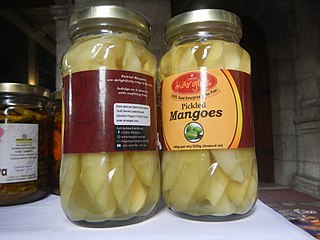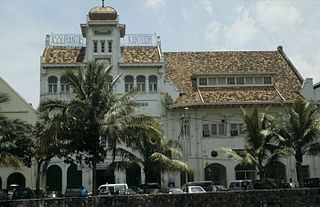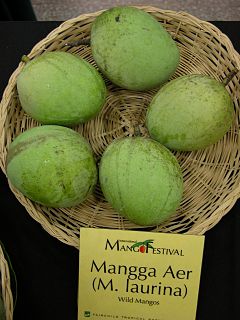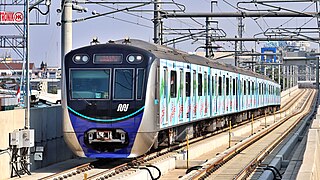Related Research Articles
The Mohe, Malgal, or Mogher, maybe a mispronunciation of the word Mojie, were an East Asian Tungusic people who lived primarily in the modern geographical region of Northeast Asia. The two most powerful Mohe groups were known as the Heishui Mohe, located along the Amur River, and the Sumo Mohe, named after the Songhua River.

Glodok is an urban village of Taman Sari, West Jakarta, Indonesia. The area is also known as Pecinan or Chinatown since the Dutch colonial era, and is considered the biggest in Indonesia. Majority of the traders and residents of Glodok are Chinese descent. The area dates back to colonial times when in November 1740, Dutch East Indies Company designated Glodok as a residential area for ethnic Chinese. Administratively, the area is a kelurahan under the Taman Sari district, West Jakarta.

Burong mangga is a Filipino side dish made by mixing sugar, salt, and water to mangoes that have previously been salted. The mixture of water and sugar should be boiled and cooled first, before pouring it over the salted mangoes. Some variants add chilis to the cooled sugar water mixture. Original "basic" burong mangga is made using a brine solution and pouring it over halved unripe or partially ripe mangoes. Mango cultivars commonly used for burong mangga include 'Carabao' mangoes and 'Pico' mangoes.
The South Huon Gulf languages are a linkage of the Huon Gulf languages of Papua New Guinea.

Curcuma amada, or mango ginger is a plant of the ginger family Zingiberaceae and is closely related to turmeric. The rhizomes are very similar to common ginger but lack its pungency, and instead have a raw mango flavour. They are used in making pickles in south India and chutneys in north India. It is served as chutney in community feasts in Nepal's southern plains. Mango ginger and elephant foot yam pickle is popular in Nepal's southern plains. The taxonomy of the species is a subject of some confusion as some authorities have considered the name C. mangga as identical while others describe it as a distinct species with C. mangga being found in southern India while C. amada is of east Indian origin. Mango-ginger is a popular spice and vegetable due to its rich flavor, which is described as sweet with subtle earthy floral and pepper overtones and similar to that of raw mango. It is a delicious addition to salads and stir fries. It is used in South Asian and Southeast Asian as well as Far East Asian cuisines.

Taman Sari is a district of West Jakarta, Indonesia. It is the smallest subdistrict of West Jakarta (4.37 km2). It is bounded by Central Jakarta to the south and to the east, and by Pademangan in North Jakarta to the north.
Jagakarsa is a district of South Jakarta, one of the administrative cities in Jakarta Indonesia. Jagakarsa is the southernmost district of South Jakarta Jagakarsa District is bounded by Ciliwung River to the east, Krukut River to the west, and Margasatwa-Sagu-Joe-T.B.Simatupang-Poltangan Road to the north, while the boundary marches with Depok city to the south.
San Jose del Monte station is an under-construction Manila Metro Rail Transit (MRT) station situated on Line 7. Located in San Jose del Monte, Bulacan, it is the northern terminus of the line.

The Governor Fortunato F. Halili Avenue or simply the Governor Halili Ave, is a two-to-four lane national road and one of the major thoroughfares of the city of San Jose del Monte and the municipalities of Santa Maria and Bocaue in Bulacan, Philippines, named after the former governor of Bulacan. Many establishments are located along this 6 kilometer road.

Kampung Bandan Station (KPB) is a railway station located on the border of North Jakarta and Central Jakarta. This station is located close to WTC Mangga Dua.

Mangifera laurina is a species of flowering plant in the family Anacardiaceae. It commonly known as mangga kopyor, mangga pari in Indonesian.

Mangga Besar Station is a railway station serving by KRL Commuterline system. It's located at Jl. Mangga Besar Raya. It is the named after the major artery road that lies adjacent to the station with the same name, and is also part of the rail system's "Zone 1".

Mangga Dua is a shopping district at Pademangan subdistrict of North Jakarta, in Indonesia. The area is bordered by Jalan Gajah Mada in the west and Jalan Gunung Sahari in the east, while in the middle is Jalan Pangeran Jayakarta and Jalan Mangga Dua Raya. Mangga Dua is part of Jakarta's long history starting from Sunda Kelapa port and Glodok, which is biggest China town in Indonesia. The area is one of the 12 coastal tourism spots to attract foreign tourists by Dinas Pariwisata dan Kebudayaan. Mangga Dua and the contiguous Glodok are one of the biggest shopping areas in southeast Asia.
Mangga Besar is an administrative village of Taman Sari, West Jakarta, Indonesia.This village is adjacent to Pinangsia Road (Glodok) in the north, Ciliwung River to the west, Tangki to the east and Mangga Besar Road in the south. The neighborhood is a popular nightlife destination in Jakarta.

Crema de fruta is a traditional Filipino fruitcake made with layers of sponge cake, sweet custard or whipped cream, gelatin or gulaman (agar), and various preserved or fresh fruits, including mangoes, pineapples, cherries, and strawberries. It is usually served during the Christmas season. It has multiple variations, ranging from changes in the fruits used to the addition of ingredients like jam, sago, condensed milk, and others.

Mango float or crema de mangga is a Filipino icebox cake dessert made with layers of ladyfingers (broas) or graham crackers, whipped cream, condensed milk, and ripe carabao mangoes. It is chilled for a few hours before serving, though it can also be frozen to give it an ice cream-like consistency. It is a modern variant of the traditional Filipino crema de fruta cake. It is also known by various other names like mango refrigerator cake, mango graham float, mango royale, and mango icebox cake, among others. Crema de mangga is another version that additionally uses custard and gulaman (agar) or gelatin, as in the original crema de fruta.

Burong isda is a Filipino dish consisting of cooked rice and raw filleted fish fermented with salt and angkak for around a week. The dish is common in central Luzon, most notably in the province of Pampanga. Angkak may also be omitted, especially in western central Luzon, resulting in a white-colored version. Burong isda variants are usually named after the fish they were made with; e.g. burong bangus for burong isda made with bangus (milkfish). Shrimp versions of the dish are known as burong hipon or balao-balao. Burong isda is very similar to other fermented fish and rice dishes of Asia, including narezushi of Japanese cuisine and pla ra of Thai cuisine. All of these dishes rely on lactic acid fermentation to preserve the food.
Tinapayan is a Filipino dish consisting of tapay and dried fish. It originates from the Maguindanao people. It is very similar to the more widespread northern dish burong isda, but differs in that the fish is dried first.

The North–South line is a rapid transit line of the Jakarta MRT. Coloured darker red on the map, the line is currently 15.7 km long and serves 13 stations. It is the first line of the Jakarta MRT.
References
- ↑ Mangga at Ethnologue (18th ed., 2015) (subscription required)